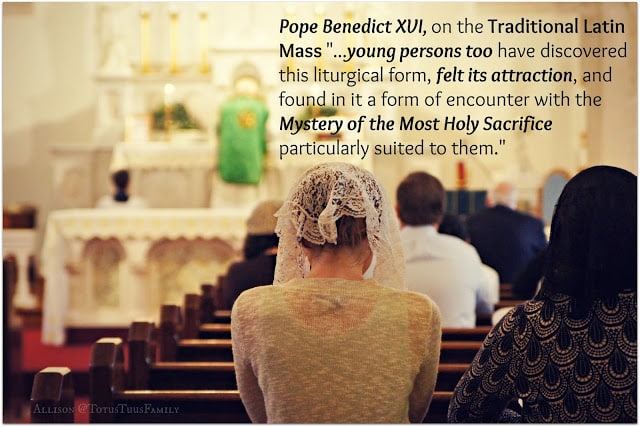
Christian Modesty and Modes of Dress
We are all born with a fallen nature and, consequently, we must keep our bodies covered in order to avoid the dangers of concupiscence. This fact, a result of original sin, is deliberately ignored each time that naturalism attempts to insinuate itself into our Christian customs. Then it is that the purpose of clothing is lost sight of, and instead of being an invitation to virtue, it becomes an incitement to sin. The Church, like a vigilant Mother, full of tender care for the holiness and eternal salvation of Her children, has often been obliged to warn the faithful so that they might avoid the errors of fashion, and to take the measures necessary to ensure that the holy places and sacred things should not be profaned by immodesty in dress.
Unfortunately, we are living in times that have lost the sense of sin and, as a result, we see around us an eruption of styles of dress which are, in every way, contrary to Christian modesty. Christian people must not allow themselves to be carried along by the spirit of the world but must firmly resist such deviations… Jacinta Marto, one of the little seers of Fatima, although she was only eleven years old at the time, had a wisdom taught her by the Mother of God.
She merits, therefore, our attention. Here is what she said with regard to styles of dress: “Fashions will arise which will greatly offend God.” When we consider the fashions of our day, we are led to conclude that the times foretold by the little seer have arrived. Indeed, the styles of dress of the women and girls of today such as: very tight clothing; dressing like men, including slacks and tights; low necklines; skirts with hemlines or slits which do not cover the leg below the knee – are absolutely contrary to the norms of Christian modesty.
For this reason, in order to conform to the recommendations of the Holy See, and in particular to the instructions of the Sacred Congregation of the Council, we urge our faithful people to refrain from following such ways of dressing.
“Those who keep the Law of God”, Jacinta said, “should not follow fashions”. Our priests must try to apply the instructions of the Sacred Congregation of the Council, without violence or rudeness, but with firmness. They must not let persons, dressed in the styles described above, receive the Sacraments and, as far as possible, must not allow them access to the Temple of God.
Furthermore, they must frequently remind the faithful of these regulations. Also, when couples present themselves for marriage preparation, the priests must tell them to inform their wedding guests of the rules for dress in church. People dressed in these unacceptable ways must not be accepted as witnesses to the marriage and, after due warning, they must not be admitted to Holy Communion.
It is highly recommended that these prescriptions be posted at the entrance to the church.
–Bishop Antonio de Castro-Mayer–
Modesty Standards
On January 12, 1930, the Sacred Congregation of the Council, by mandate of Pope Pius XI, issued emphatic instructions on modesty of dress to all bishops, directing them to insist on these prescriptions: “We recall that a dress cannot be called decent which is cut deeper than two fingers breadth under the pit of the throat, which does not cover the arms at least to the elbows, and scarcely reaches a bit beyond the knee. Furthermore, dresses of transparent material are improper.
“Let parents keep their daughters away from public gymnastic games and contests; but, if their daughters are compelled to attend such exhibitions, let them see to it that they are fully and modestly dressed. Let them never permit their daughters to don immodest garb.”
Rufino J. Cardinal Santos, Archbishop of Manila, also quotes these standards as “The Church’s Stand concerning Modesty in Dress” in his Pastoral of December 6, 1959. The feminine loss of the sense of modesty was indicated by Pope Pius XII who said: “Now many girls do not see anything wrong with following certain shameless styles (fashions) like so many sheep. They would surely blush if they could only guess the impressions they make and the feelings they evoke (arouse) in those who see them.” (July 17, 1954.)
“O Christian mothers, if only you knew the future distress, peril and ill-restrained shame that you prepare for your sons and daughters by imprudently accustoming them to live barely clothed, and permitting them to lose the sense of modesty, you would be ashamed of yourselves, and of the harm done to the little ones entrusted to you by Heaven to be reared in a Christian dignity and culture.”
And, men also are held to the virtue of modesty; witness the admonition of Canadian bishops in May of 1946: “Man himself does not escape from the inclination of exhibiting his flesh: some go in public, stripped to the waist, or in very tight pants or in very scanty bathing suits. They thus commit offenses against the virtue of modesty. They may also be an occasion of sin (in thought or desire) for our neighbor.”
The opinion which allows custom to dictate the question of modesty was refuted by Pope Pius XII in one short sentence: “There always exists an absolute norm to be preserved.”
Custom, of course, pays no attention to absolute norms; but, it is a follower of this false principle: “… the majority cannot go wrong.”
To say that “… modesty is a matter of custom” is just as wrong as to say that “… honesty is a matter of custom.”
What about those who teach “What is customary does not affect us?”
Pope Pius XII calls this application of an ancient principle to the virtue of modesty, “the most insidious of sophisms.” He calls attention to the fact that some people use this sophism “…in order to brand as ‘old fashioned’ the rebellion of honest people against fashions they consider too bold.”
The Pope’s pronouncements make no distinctions for various types of garments. Pius XII states “…an unworthy, an indecent mode of dress has prevailed” without any distinction of place, “on beaches, in country resorts, on the streets, etc.” (Aug. 29. 1954)
His quotation: “Vice necessarily follows upon public nudity,” applies as well to the beaches, or the streets, or resorts, or elsewhere.
Cardinal Pla y Daniel, Archbishop of Toledo, Spain, stated in 1959: “A special danger to morals is represented by public bathing at beaches… Mixed bathing between men and women, which is nearly always a proximate occasion of sin and a scandal, must be avoided.”
Modern Catholics may now consider themselves “far too adult” and disdain such directives, but nevertheless they remain the wise counsels of our Holy Mother the Church.
Padre Pio on Christian Modesty
The saintly stigmatized Padre Pio was always a merciless enemy of feminine vanity: he never tolerated low-necked dresses, short and or tight fitting skirts, and forbade his spiritual children to wear transparent stockings. In the last few years of his life, his severity increased enormously, as fashions became more and more immodest.
He unrelentingly dismissed from his confessional, before they could step inside, all women he judged to be incorrectly dressed. By 1967, on some mornings, he turned them away one after another, until he ended up confessing very few. His brethren noticed this with a certain unease, then decided to post on the door of the church a warning: “By Padre Pio’s explicit wish, women must enter the confessional wearing skirts AT LEAST 8 INCHES BELOW THE KNEE. It is forbidden to borrow longer dresses in church and to wear them to confession.”
The beginning of the struggle with no concessions whatsoever coincided more or less with the advent of the mini-skirt, launched by the English girl Mary Quant. It had not yet reached Italy as Padre Pio was thundering against short skirts. As fashion houses announced: “Eight inches above the knee”, Padre Pio warned: “Eight inches below the knee”.
When Summer is Here
When summer comes, a pastor of souls worries a little more than usual about the salvation of the flock that Our Lord has confided to him. He knows that, in the summer season, souls are more exposed to occasions of offending God, “of attacking God with His won gifts”, especially through sinful fashions of dress.
Our Lady said to Sister Lucy at Fatima: “There will be fashions which will greatly offend My Divine Son”. Today’s fashions prove Our Lady’s words true, for these fashions are occasions of sin, occasions, alas, of serious sin, by reason of the sinful thoughts and desires which they provoke. In the Gospel, Our Lord warned us about such evil desires: “But I say to you, that whosoever shall look on a woman to lust after her, hath already committed adultery with her in his heart.” (Mt.5:28).
In the life of Saint Frances of Rome, we read of a vision of Hell which was granted her, and which lasted for four hours. God willed to show her, in the fires of Hell, certain ladies whom she had known in Roman society. For what sins had these souls been damned? They had been damned:
- for guilty desires, even though these had not been put into act.
- for indecent styles of dress, which were the fashion of the day, and which had been a cause of seduction and of sin.
- for dances, considered inoffensive by the world.
This vision of Hell so marked Saint Frances of Rome, that she had it painted on the murals of her chapel, as a constant reminder of the judgments of God. God then gave her the mission of drawing the Roman ladies out of their luxury and their vanity.
Our society is much worse than the society of Renaissance Rome. What can we do in order not to yield to the corruption which surrounds us, especially in the matter of dress? Let us, first of all, recall certain Catholic principles. It was with the help of such principles that Father Emmanuel, at Mesnil Saint-Loup, was able to make his Parish a truly Christian society once again.
Christianity is stable and solid only insofar as it permeates the whole being of the baptized person. It must, first of all, penetrate the inner man, and transform him into the image of Jesus Christ, in order to then regulate, according to this image, his exterior actions, words, and attitudes. It is not sufficient, Saint Paul tells us, for the heart to believe; we must also confess with our mouth, if we wish to be saved. And this external confession must extend to all our gestures, movements, habits, and relationships.
From this, it is easy to understand the importance of modesty for women. A woman who is vain gives the lie to her baptismal promises. A woman who tries to attract men’s glances to herself, shows by this conduct that she has no desire to please Jesus Christ.
In Holy Communion, Our Lord takes possession of our whole being, so that the soul becomes subject to Him in humility, and the body in modesty and restraint. From which it follows that a person who goes to Communion must be different, even exteriorly, from one who does not.
Modesty in a woman is the sign that Jesus Christ dwells in her heart. It is a sweet perfume of edification which she is called upon to diffuse.
Modesty in dress and behavior is, therefore, an indispensable way of making us more attentive to the obligations which we contracted at our Baptism. It is a consequence of that dogma of Faith which tells us that the baptized soul is the dwelling of the Blessed Trinity and that the body is the Temple of the Holy Ghost. Saint Paul, infallibly inspired by God, tells us: “Know you not that your members are the temple of the Holy Ghost, Who is in you, Whom you have from God, and you are not your own?… Glorify and bear God in your body”. (1 Cor.6:19-20).
Today’s fashions, on the contrary, dishonor and corrupt the Christian woman. Their aim is to seduce and to arouse concupiscence, to the detriment of the soul’s spiritual beauty, which is the true goal of our lives. All of this is a strategic Masonic maneuver. The destruction of Christian society, for which the Lodges have been working for two centuries, is to be realized through the destruction of the virtue of modesty in those who are baptized. This corruption, which has been deliberately and carefully programmed, is being systematically brought about.
It is, therefore, always necessary to remember the indispensable rules of Christian modesty, rules which are not to be practiced only in church! Let us, then, look at these rules, first in general, and then, in particular, with regard to assistance at Mass.
IN GENERAL, clothes should hide the shape of the body rather than accentuate it. Only this kind of clothing can truly be called “decent”. This rule automatically excludes slacks (which are masculine apparel) for women. Feminine apparel is a skirt or a dress which must cover the woman’s knees when she is seated. Decency in dress is to be observed, not only at Mass on Sundays, but every day of the week. The deciding factor is not whether slacks or culottes are more comfortable than a skirt, but rather to do the Will of God, by “loving Him in all things and above all things” (Collect of the 6th Sunday after Pentecost).
IN PARTICULAR, when attending Mass, we must be still more careful about how we dress. For instance, women must cover their heads: “Every woman praying …with her head not covered, disgraces her head” (1 Cor.11:5). This rule has been the constant teaching of the Popes, and Pope St. Pius X had it included in the Code of Canon Law (Canon 1262).

It is a sign of humility and submission for a woman to cover her head, and draws down God’s graces and blessings upon her. Now is it an indifferent matter, just as no exterior act is an indifferent matter, for it proceeds from our very person and reveals what kind of person we are.
Both men and women must have their arms covered in church, even when the weather is warm. It is true that this is a sacrifice, and we should offer it to Our Lord, who suffered so much for us in His Body, in order to save us. Let us learn to imitate Him in mortifying our body.
We must hold to these rules, of which we are mentioning only the most essential, without human respect, especially in these times of ours. For, as Dom Bernard Marechaux used to say:
The evil of our day is this: that the line of demarcation between Christian and non-Christian, between Christian and heretic, between Christian and idolater, is gradually fading away. The cancer of Liberalism attacks everyone and we must be careful not to be infected ourselves. Those who still call themselves Catholic live, too often, like those who have renounced this title. Women who go to church dress just the way women who do not go to church dress; they read the same books and magazines as these women; they go to the same – often immoral – shows as these women; they no longer pray or do penance. It is a confusion of license and worldliness. As a result of these customs, the Church is beginning to disappear in the world. Christianity is being lost. Only rarely does one find Catholics to whom the following words of Saint Paul can apply: “…be blameless and sincere children of God, without reproof, in the midst of a crooked and perverse generation; among whom you shine as lights in the world”. (Phil.2:15). The early Christians stood out among the pagans like shining torches in the dark, and the example of their courage and their virtue attracted the pagans strongly to the Faith. This is something which we do not see today, except in rare cases. Everything is a mish-mash of unrestraint.
Pope Pius XII said substantially the same thing, in an allocution to young Catholic girls during World War II: (May 22, 1941):
…Numbers of believing and pious women…in accepting to follow certain bold fashions, break down, by their example, the resistance of many other women to such fashions, which may become for them the cause of spiritual ruin. As long as these provocative styles remain identified with women of doubtful virtue, good women do not dare to follow them; but once these styles have been accepted by women of good reputation, decent women soon follow their example, and are carried along by the tide into possible disaster.
Pope Pius XII indeed called Catholics to a Crusade of Purity. Good example is a great act of charity. It is an apostolate which God richly blesses, as we can see, for instance, in the diocese of Campos in Brazil, where the priests followed the good example of their bishop, Monsignor de Castro Mayer. Traditional priests – alas still few in number – are eager to have such a Crusade of Purity. In France, we can see the good that is being done by the “Mouvement de la Jeunesse Catholique de France”, and by traditional Catholic schools, in producing Catholics who are enthusiastically practicing the virtue of Christian modesty (which does not, by the way, prevent a woman from being gracious and lovely). In other countries, too, this Crusade is producing visible fruits of goodness and holiness.
We must mention here the important role of Christian mothers in teaching their children, their daughters especially, and from the time that they are very little, a true sense of Christian modesty. “Men are lost through women and they are saved through women”, a preacher said one day. “By their vanity, they will make a man fall; by their modesty, they will save him. The world of morality oscillates between Eve and Mary. As long as modesty is not practiced, the world will not rise from its decadence.”
May devotion to the Holy Family help us in our Crusade for Purity!
Our Lady of Holy Hope, convert us!
This article comes from the Spring/Summer 1998 issue of The Fatima Crusader.

VIRGÓ SACRÁTA is a Christian mission-driven online resource and shop inspired from the beauty of Catholic faith, tradition, and arts. Our mission is to “Restore All Things to Christ!”, in continuing the legacy of Pope St. Pius X under the patronage of the Blessed Virgin Mary. “Who is she that cometh forth as the morning rising, fair as the moon, bright as the sun, terrible as an army set in battle array?” O Mary, conceived without sin, pray for us who have recourse to Thee.













